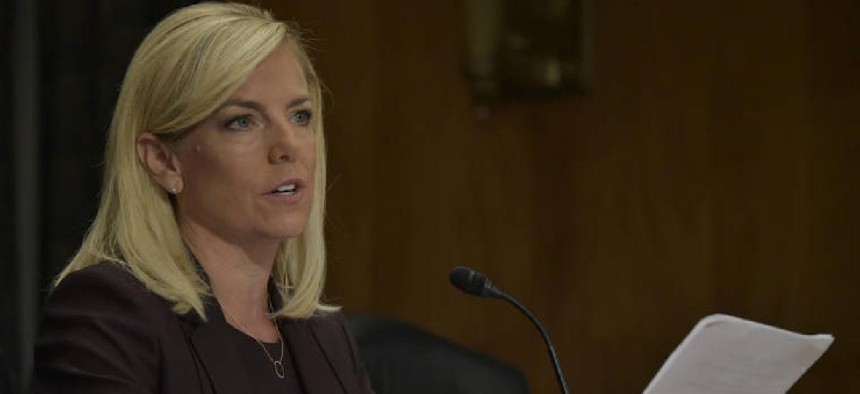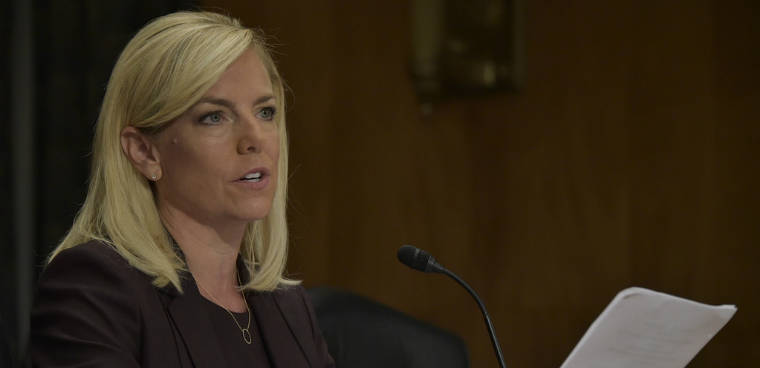DHS chief Nielsen resigns

Kirstjen Nielsen, the first Homeland Security secretary with a background in cybersecurity, is being replaced on an acting basis by the Customs and Border Protection chief. Her last day is April 10.

Former DHS Secretary Kirstjen Nielsen, shown here at her Nov. 8, 2017, confirmation hearing.
Kirstjen Nielsen, the first Homeland Security secretary with a background in cybersecurity, resigned April 7, and is being replaced on an acting basis by the Customs and Border Protection chief.
The resignation occurred suddenly, after a Sunday afternoon White House meeting between Nielsen and President Donald Trump. Trump announced the move on Twitter. The Washington Post reported that Nielsen had been forced to resign at the meeting.
Later Sunday evening, Nielsen announced on Twitter that she has "agreed to stay on as Secretary through Wednesday, April 10th to assist with an orderly transition and ensure that key DHS missions are not impacted."
Nielsen's struggles in the Trump administration largely appeared to stem from a perception that she wasn't a strong force for advocating for new immigration restrictions, tougher enforcement and a border wall.
In her resignation letter, Nielsen touted successes on the cybersecurity front and said she hoped the next DHS leader would "have the support of Congress and the courts in fixing" immigration laws.
In her resignation letter, Nielsen said she was "immensely proud of our success in transforming DHS to keep pace with our enemies and adversaries -- whether it's in cyberspace or against emerging threats from new technologies." She added that the United States government has "replaced complacency with consequences in cyberspace, we are holding digital intruders accountable, and we are stepping up our protection of American networks."
Kevin McAleenan, head of CBP, is replacing Nielsen on an acting basis.
In January, Sen. Jeff Merkley (D-Ore.) asked the FBI to open a perjury probe after Nielsen testified under oath that DHS did not have a policy of separating families at the U.S.-Mexico border.
Additionally, immigration hardliners in the White House have complained that Nielsen was not doing enough to discourage asylum seekers from entering the U.S.
Cyber chops
Nielsen brought an unusually extensive cybersecurity background to the job of DHS Secretary. She had been on the White House National Security Council during the George W. Bush administration and a senior fellow and member of George Washington University's Center for Cyber & Homeland Security Resilience Task Force before taking on the top DHS position.
Nielsen has moved ahead with, and implemented important cybersecurity efforts at the agency, including driving closer collaboration with the private sector on sharing threat information. In July 2018, she announced the National Risk Management Center in New York to reach out to partners in industry and state governments to set partnerships and identify and define national critical functions. She has also overseen collaboration with state and local governments and intelligence agencies on election security.
Suzanne Spaulding, formerly a top cyber official at DHS and now a senior advisor in the Center for Strategic and International Studies' Homeland Security and International Security programs, said before news of the resignation broke that if the White House planned to remove Nielsen, it was crucial to have a ready replacement that could take the helm as soon as possible. The White House still has not filled the agency's deputy secretary position vacated by Elaine Duke last April.
"The challenge is that the White House is overwhelmingly focused on the border," Spaulding said.
Rep. Bennie Thompson (D-Miss.), chairman of the House Homeland Security Committee, also fretted about the lack of a Senate-confirmed management team at DHS.
"This could not come at a worse time for the day to day management of the Department of Homeland Security and the over 220,000 employees that need leadership in order to best help keep the country secure," Thompson said in a statement. "There is now currently no permanent secretary nor deputy secretary at the department. The department will quickly need proven, Senate-confirmed leaders in place that can work with Congress in good faith to help keep the country safe and to fix the Trump-inflicted situation at the border."
Nielsen's departure won't affect the agency's day-to-day cyber protection for the .gov and .com environments, or its efforts to help protect vulnerable critical infrastructure networks, a policy analyst in Washington told FCW on background. However, a long replacement cycle that has plagued past agency vacancies could have a more insidious effect on DHS cybersecurity efforts.
Technology and attacks skip ahead of the agency's ability to keep up with changes in tactics, the analyst said. A gap could also complicate the federal government's ability to keep track of interagency cybersecurity efforts, he said.
Spaulding agreed with that assessment, and added that the loss of a central figure like the DHS secretary just adds to a loss of senior level cyber officials in government, given that the White House cyber coordinator position was eliminated in May 2018.





